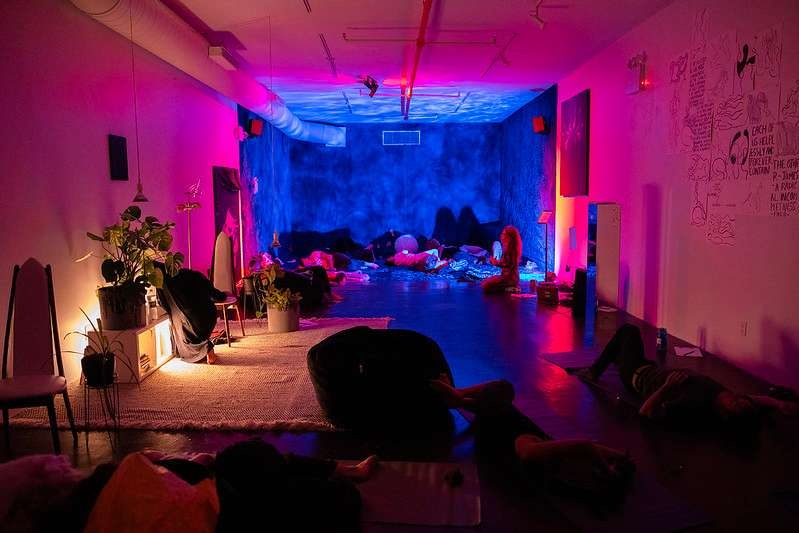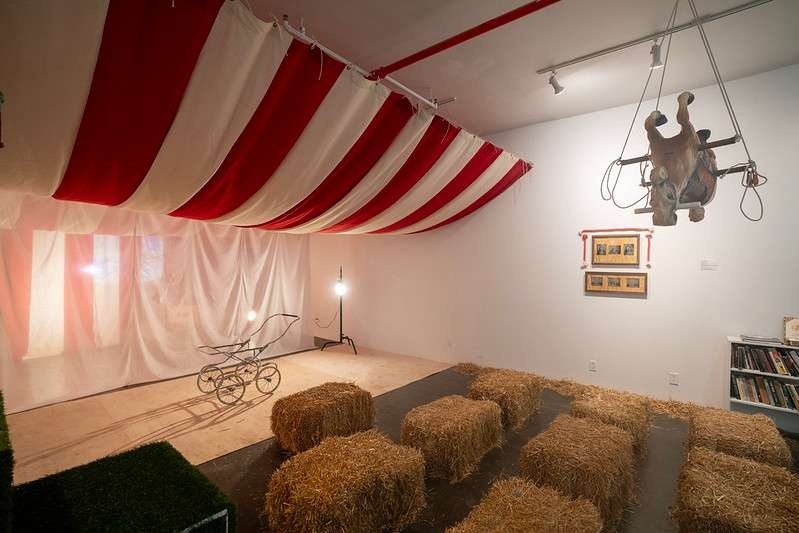The historian, rather than being an objective chronicler of events, works more in the manner of an artist. She approaches her material — historical artifacts — with a vision, a thesis. At the same time, she allows herself to be receptive to the material; as she sculpts a narrative, she adapts her idea, senses new outcomes, and directs changes in course. The writing of history, like the making of art, demands intuition as well as observation.
In Metabolic Morphology, it is clear that the artist can operate much like a historian. Takashi Horisaki and Nina Horisaki-Christens set out to excavate an imprecise past, to cast its shape with plastics and discover its traces in public and private archives. Equipped with latex and plaster, scanners and recorders, wires and cheesecloth, they collected signs of what-once-was and assembled these diaphanous impressions into a history. To manipulate this network of facsimiles and field recordings is to literally activate a narration of the past.
This begs the question: To what extent can art become history, and history become art? Lest we forget, both art and history were more or less pronounced dead and cautiously resurrected in recent decades. Regardless if we have transitioned from one epoch to another, it seems imperative to recover our footing, to locate these two praxes and reassess their critical edges. This essay is one such attempt to cast the contours of art and history. It will borrow heavily from the theoretical work of Walter Benjamin, and it will be admittedly skewed toward an elucidation of history over art, but this is the nature of the chosen casting materials.
To analyze history, I will begin with a brief discussion of its conceptual core: the story. In his 1936 essay “The Storyteller,” Walter Benjamin proclaims that “The art of storytelling is reaching its end because the epic side of truth, wisdom, is dying out.”[1] Benjamin defines the story — be it a fairy tale, legend, or epic — by its oral transmission, its deep resonance with its audience of listeners. For him, the story has long served an important social function: to weave past wisdom into present experience, precisely through repeated retellings. Clearly, history, in its effort to reconcile the past with the present, falls within the parameters of the story. The decline of storytelling thus has significant consequences for the writing of history, as does the rise of the communicative form that is superseding it: information.
“Every morning brings us the news of the globe,” writes Benjamin in the same essay, “and yet we are poor in noteworthy stories.”[2] For Benjamin, information — exemplified by daily news — proves spiritually incompatible with storytelling. What defines information is its “claim to prompt verifiability.” Information is “shot through with explanation”; it appears to be “understandable in itself.” While storytelling leaves room for individual interpretation, information fills these lacunae with causal connections and speculative analysis. As a result, the content of information, unlike the counsel of the story, is fleeting: It “does not survive the moment in which it was new.”[3] In place of the repeatedly recited epic poem, we have the 24-hour news cycle, the constantly refreshing Twitter feed.
To put this argument simply, information sacrifices memorability for immediacy — the “claim to prompt verifiability.” What Benjamin theorizes is a contraction of time. Already in 1936 we are veering ever close to the end of history, to the amnesic forgetting of the past and the commencement of the “eternal present” — the contemporary moment of information. To redeem history, then, is to resist the alluring immediacy of information and recover the art of storytelling. Of course, this does not imply a simple return to pre-novel literary forms. Rather, it calls for a narration of history that reproduces the terms of the story. History must induce its own retelling, its own assimilation into contemporary experience; it must make the past meaningful for the present.
Here is where art comes in. Almost by definition, art harnesses the existing to generate the new. Given its materiality, art is unequivocally committed to the present but, at the same time, entirely reliant on what preceded its becoming. As T.S. Eliot once proclaimed, the modern poet must write with a sense of “not only the pastness of the past, but of it presence; the historical sense compels a man to write not merely with his own generation in his bones, but with a feeling that the whole of the literature of Europe from Homer…has a simultaneous existence.”[4] While neither the production or reception of art requires a sense of the “whole” of art history, these processes engage directly with what Eliot calls “tradition” by appropriating its techniques, using its materials, and citing its contents. In this way, art actively makes the past meaningful for the present. What is more, art refracts the present; its unquestionable contemporaneity allows art to adumbrate alternative presents — to anticipate a future.
Returning to Metabolic Morphology, Benjamin’s analogy of storytelling as a process of “weaving and spinning” could hardly be more appropriate: Horisaki and Horisaki-Christens thread together fragments of the past into a protean, fiber-optic web, imploring viewers to participate in its shaping. Their representation of history is not a timeline but a constellation perforated with gaps, ambiguities, and caesuras. These spaces and silences do not render their simulacrum less accurate. Rather, accuracy is distributed unconventionally, concentrated into life-sized casts and recorded voices. Through this latticework of form and formlessness, history slips into the present and dialogues with an indefinite future.
What I have attempted to establish thus far is that both art and history partake in a dialectic between subjective and objective representation; both appeal to interpretive analysis as well as documentary recording. Yet despite their flirtations, art and history occupy distinct places in our cultural continuum. Their boundaries are often blurred, but never altogether dissolved. How can we explain this dividing force? Is it a force of habit? of mere cognitive inertia? To rephrase our initial question: could we will history to become art, and art to become history? My sense is that we cannot — at least not yet. For it is not that art and history are more or less abstract versions of the same thing, merely two media performing the same semantic balancing act. The subject of their criticism — and thus their aesthetic means of critique — are fundamentally different: history relies on its “prompt verifiability” in the present to articulate the past, while art subverts its own “prompt verifiability” in anticipation of the future. Both actions are mutually influential and equally vital.
To elucidate this final point, we return once more to Metabolic Morphology. Despite its resemblance to archaeology, perhaps the greatest virtue of the project is its gathering of forces in the present. Metabolic Morphology foregrounds the moment of creation, the collision of trajectories and their crystallization into form. As we have seen, the writing of history likewise generates a new form: a story. But history also embraces its semblance to information — its claim to prompt verifiability — in order to perform its most crucial task: the representation of historical time. To write history is to contract and expand past moments and epochs, to calibrate junctures and fine-tune paradigm shifts. To do this, the historian manipulates the accepted terms of the present. She operates as a double agent, wielding thepretense of objectivity precisely to critique its foundations. For history, at its best, enables us to imagine a heterogeneous past, if only for a moment. To imagine a heterogeneous future, we turn in the direction of art.
About the artist
Kelly Chan
Kelly Chan studies art and architectural history at Columbia University. She formerly wrote about architecture for ArtInfo.com.
Projects
Explore/Archive
See allDecember 2025
The INSTITUTE FOR TRANSHUMANIST CEPHALOPOD EVOLUTION and Learning from Octopuses
Barbara London
Barbara London reflect's of Miriam SImun's INSTITUTE FOR TRANSHUMANIST CEPHALOPOD EVOLUTION
October 2025
streamlined reflections, courtesy of noise canceling headphones
Gabrielle Rucker
Gabrielle Rucker reflects on the radical intimacy and auditory life at the heart of Deli Radio
July 2025
Tell My Jockey: CUNTRY’s Discourse From the Horse’s Mouth
Ericka Pérez
Assembly fellow Ericka Pérez reflects on clowning, resistance, and CUNTRY’s radical refusal to perform.





